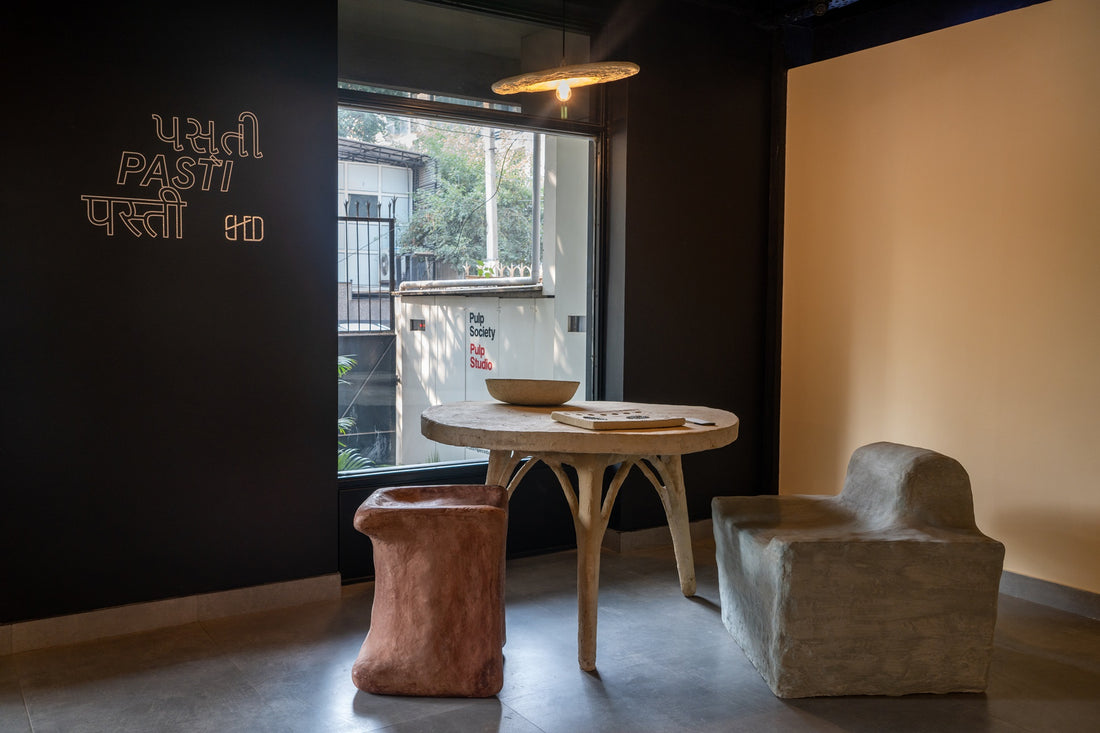Pasti, an exhibition with paper clay monolithic hand-moulded functional objects and works by SHED.
“A traditional Indian household is embedded with simple practices which take care of waste and refuse on the go – one such practice is to collect all the paper that a household accumulates over a period of time, immersing it in water and storing it in an earthen urn to slowly soften the fibres. Once a sizeable amount of pulp is gathered, this softened cellulose is mixed with sticky clay into a dough-like consistency. The mixture is applied in thin layers on the curved bottoms of earthen pots one has lying around at home, up to the diameter that one wants. A few days later, the mixture hardens into a curved platter and separates from the pot that gave it its form. These platters are used to store vegetables and fruits away from rodents at dry spaces in a kitchen.
What struck us is the ingenuity of this domestic practice in its simplicity and how intrinsically it is woven into the metabolic flows of a home (and nature) without being energy intensive. Yes, it is a process that asks for human effort, but dependance on other virgin resources is minuscule.
My grandmother fondly tells me of anecdotes when they got together to make these ‘taavdis’ before plastic baskets replaced them, often improvising on the mixtures by adding fenugreek paste, rice starch, as well as other sticky river clays, sometimes painting on top of them with fired terracotta powdered to a red paste (gheru) and so on, to lend the final pieces subtly different characteristics depending on use.
It is this very practice that we decided to bring into the studio, albeit getting more ambitious with scale. So far with our experiments and explorations, we find that this material is versatile and self-binding no matter the size, lending to bold monolithic forms in furniture with almost rock-solid tactility.
The wet mixture is applied by hand on sturdy framework (our material of choice being bamboo tied with coconut coir rope) in layers. The material imbibes impressions made on it, warping and distorting like it has a mind of its own, as the forces of nature act upon it to dry and shrink it over time. Cracks appear, ridges form and there is a texture that develops; we can either embrace this as it is or further sand it down, tame it, smoothen it till we want. The more the human hand goes over these surfaces, there develops a sheen although on a rugged surface because of the presence of clay.
We’ve come to play with the material here at the studio in different ways – adding herbal pigments (madder roots and indigo) in different proportions to lend a range of tones or even hydrated lime to whiten the final product further, and finally embedding pieces of coloured glass and mirror in it while it hardens into a form permanently casing them in!
Paperclay is a surprisingly simple material to touch-up and repair just with the help of water and the parent mixture – forever dispelling the use of toxic adhesives of any kind over its lifetime. Once it lives out it’s time too, it’ll innocently go back to the ground with no damage. This series of paperclay furniture is a bid to surround oneself with this magic material cooked up by my grandmother (amongst many other such home-cooks!) and reclaim some of that hand-made simplicity in our otherwise mass-produced lives.” - Priyanka Shah, principal designer, and founder, the SHED.
Pasti, by SHED

